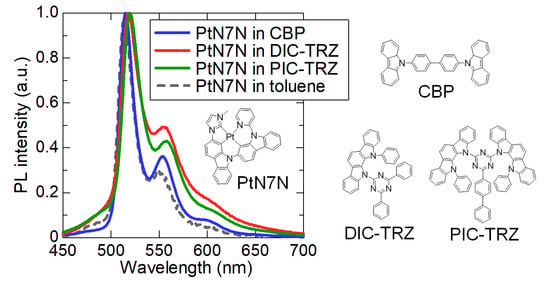Effect of Host Moieties on the Phosphorescent Spectrum of Green Platinum Complex
Abstract
:1. Introduction
2. Results and Discussion
2.1. Effect of the Acceptor Moieties in Host Materials on the Emission Spectrum of PtN7N
2.2. Verification of the Spectral Change by Employing Host Materials Without Carbazole Units
2.3. Verification of the Spectral Change by Employing Host Materials With Different Energy Levels
2.4. Effect of Steric Hindrance in the Host Materials on the Emission Spectrum of PtN7N
3. Materials and Methods
3.1. Fabrication of OLEDs
3.2. Photoluminescence Measurement
3.3. Energy Level Measurement
3.4. Calculation of the Optimized Structures
4. Conclusions
Supplementary Materials
Author Contributions
Funding
Conflicts of Interest
References
- Fleetham, T.; Li, G.; Wen, L.; Li, J. Efficient “Pure” blue OLEDs employing tetradentate Pt complexes with a narrow spectral bandwidth. Adv. Opt. Mater. 2014, 26, 7116–7121. [Google Scholar] [CrossRef] [PubMed]
- Fleetham, T. Organic optoelectronic devices employing small molecules. Ph.D. Thesis, Arizona State University, Arizona, AZ, USA, 2014. [Google Scholar]
- Fukagawa, H.; Shimizu, T.; Hanashima, H.; Osada, Y.; Suzuki, M. Fujikake Highly efficient and stable red phosphorescent organic light-emitting diodes using platinum complexes. Adv. Mater. 2012, 24, 5099–5103. [Google Scholar] [CrossRef] [PubMed]
- Dabbousi, B.O.; Bawendi, M.G. Electroluminescence from CdSe quantum-dot/polymer composites. Appl. Phys. Lett. 1995, 66, 1316–1318. [Google Scholar] [CrossRef]
- Manders, J.R.; Qian, L.; Titov, A.; Hyvonen, J.; Scott, J.T.; Xue, J.; Holloway, P.H. Next-generation display technology: Quantum-dot LEDs. SID Int. Symp. Dig. Tech. Pap. 2015, 46, 73–75. [Google Scholar] [CrossRef]
- Kumar, J.; Jagielski, J.; Kallikounis, N.; Kim, Y.-H.; Wolf, C.; Jenny, F.; Tian, T.; Hofer, C.J.; Chiu, Y.-C.; Stark, W.J.; et al. Ultrapure green light-emitting diodes using two-dimensional formamidinium perovskites: Achieving recommendation 2020 color coordinates. Nano. Lett. 2017, 17, 5277–5284. [Google Scholar] [CrossRef] [PubMed]
- Cho, H.; Jeong, S.H.; Park, M.H.; Kim, Y.H.; Wolf, C.; Lee, C.L.; Heo, J.H. Overcoming the electroluminescence efficiency limitations of perovskite light-emitting diodes. Science 2015, 350, 1222–1225. [Google Scholar] [CrossRef] [PubMed]
- Recommendation ITU-R BT.2020-2, Parameter Values for Ultra-High Definition Television Systems for Production and International Programme Exchange. 2015. Available online: https://www.itu.int/rec/R-REC-BT.2020-2-201510-I/en (accessed on 28 January 2019).
- Recommendation ITU-R BT.709-6, Parameter Values for the HDTV Standards for Production and International Programme Exchange. 2015. Available online: https://www.itu.int/rec/R-REC-BT.709-6-201506-I (accessed on 28 January 2019).
- Baldo, M.A.; Lamansky, S.; Burrows, P.E.; Thompson, M.E.; Forrest, S.R. Very high-efficiency green organic light-emitting devices based on electrophosphorescence. Appl. Phys. Lett. 1999, 75, 4–6. [Google Scholar] [CrossRef]
- Adachi, C.; Baldo, M.A.; Thompson, M.E.; Forrest, S.R. Nearly 100% internal phosphorescence efficiency in an organic light emitting device. J. Appl. Phys. 2001, 90, 5048–5051. [Google Scholar] [CrossRef]
- Uoyama, H.; Goushi, K.; Shizu, K.; Nomura, H.; Adachi, C. Highly efficient organic light-emitting diodes from delayed fluorescence. Nature 2012, 492, 234–238. [Google Scholar] [CrossRef] [PubMed]
- Hatakeyama, T.; Shiren, K.; Nakajima, K.; Nomura, S.; Nakatsuka, S.; Kinoshita, K.; Ni, J.; Ono, Y.; Ikuta, T. Ultrapure blue thermally activated delayed fluorescence molecules: Efficient HOMO-LUMO separation by the multiple resonance effect. Adv. Mater. 2016, 28, 2777–2781. [Google Scholar] [CrossRef]
- Fukagawa, H.; Oono, T.; Iwasaki, Y.; Hatakeyama, T.; Shimizu, T. High-efficiency ultrapure green organic light-emitting diodes. Mater. Chem. Front. 2018, 2, 704–709. [Google Scholar] [CrossRef]
- Féry, C.; Racine, B.; Vaufrey, D.; Doyeux, H.; Ciná, S. Physical mechanism responsible for the stretched exponential decay behavior of aging organic light-emitting diodes. Appl. Phys. Lett. 2005, 8, 213502. [Google Scholar] [CrossRef]
- Seo, S.; Shitagaki, S.; Ohsawa, N.; Inoue, H.; Suzuki, K.; Nowatari, H.; Yamazaki, S. Exciplex-triplet energy transfer: A new method to achieve extremely efficient organic light-emitting diode with external quantum efficiency over 30% and drive voltage below 3V. Jpn. J. Appl. Phys. 2014, 53, 042102. [Google Scholar] [CrossRef]
- Zhang, D.; Duan, L.; Zhang, D.; Qiu, Y. Towards ideal electrophosphorescent devices with low dopant concentrations: The key role of triplet up-conversion. J. Mater. Chem. C 2014, 2, 8983–8989. [Google Scholar] [CrossRef]
- Fukagawa, H.; Shimizu, T.; Kamada, T.; Kiribayashi, Y.; Osada, Y.; Hasegawa, M.; Morii, K.; Yamamoto, T. Highly efficient and stable phosphorescent organic light-emitting diodes utilizing reverse intersystem crossing of the host material. Sci. Rep. 2015, 5, 9855. [Google Scholar] [CrossRef]
- Zhang, D.; Cai, M.; Zhang, Y.; Bin, Z.; Zhang, D.; Duan, L. Simultaneous enhancement of efficiency and stability of phosphorescent OLEDs based on efficient Förster energy transfer from interface exciplex. ACS. Appl. Mater. Interfaces 2016, 8, 3825–3832. [Google Scholar] [CrossRef]
- Fukagawa, H.; Shimizu, T.; Iwasaki, Y.; Yamamoto, T. Operational lifetimes of organic light-emitting diodes dominated by Förster resonance energy transfer. Sci. Rep. 2017, 7, 1735. [Google Scholar] [CrossRef]
- Zhang, D.; Duan, L.; Li, C.; Li, Y.; Li, H.; Zhang, D.; Qiu, Y. High-efficiency fluorescent organic light-emitting devices using sensitizing hosts with a small singlet-triplet exchange energy. Adv. Mater. 2014, 26, 5050–5055. [Google Scholar] [CrossRef]
- Mataga, N.; Ezumi, K. Interaction of excited aromatic hydrocarbons with aromatic amines. Bull. Chem. Soc. Jpn. 1967, 40, 1355–1360. [Google Scholar] [CrossRef]
- Zhang, D.; Duan, L.; Zhang, D.; Qiao, J.; Dong, G.; Wang, L.; Qiu, Y. Extremely low driving voltage electrophosphorescent green organic light-emitting diodes based on a host material with small singlet-triplet exchange energy without p- or n-doping layer. Org. Electron. 2013, 14, 260–266. [Google Scholar] [CrossRef]
- Fukagawa, H.; Shimizu, T.; Kawano, H.; Yui, S.; Shinnai, T.; Iwai, A.; Tsuchiya, K.; Yamamoto, T. Novel hole-transporting materials with high triplet energy for highly efficient and stable organic light-emitting diodes. J. Phys. Chem. C 2016, 120, 18748–18755. [Google Scholar] [CrossRef]
Sample Availability: Samples of the compounds are not available from the authors. |
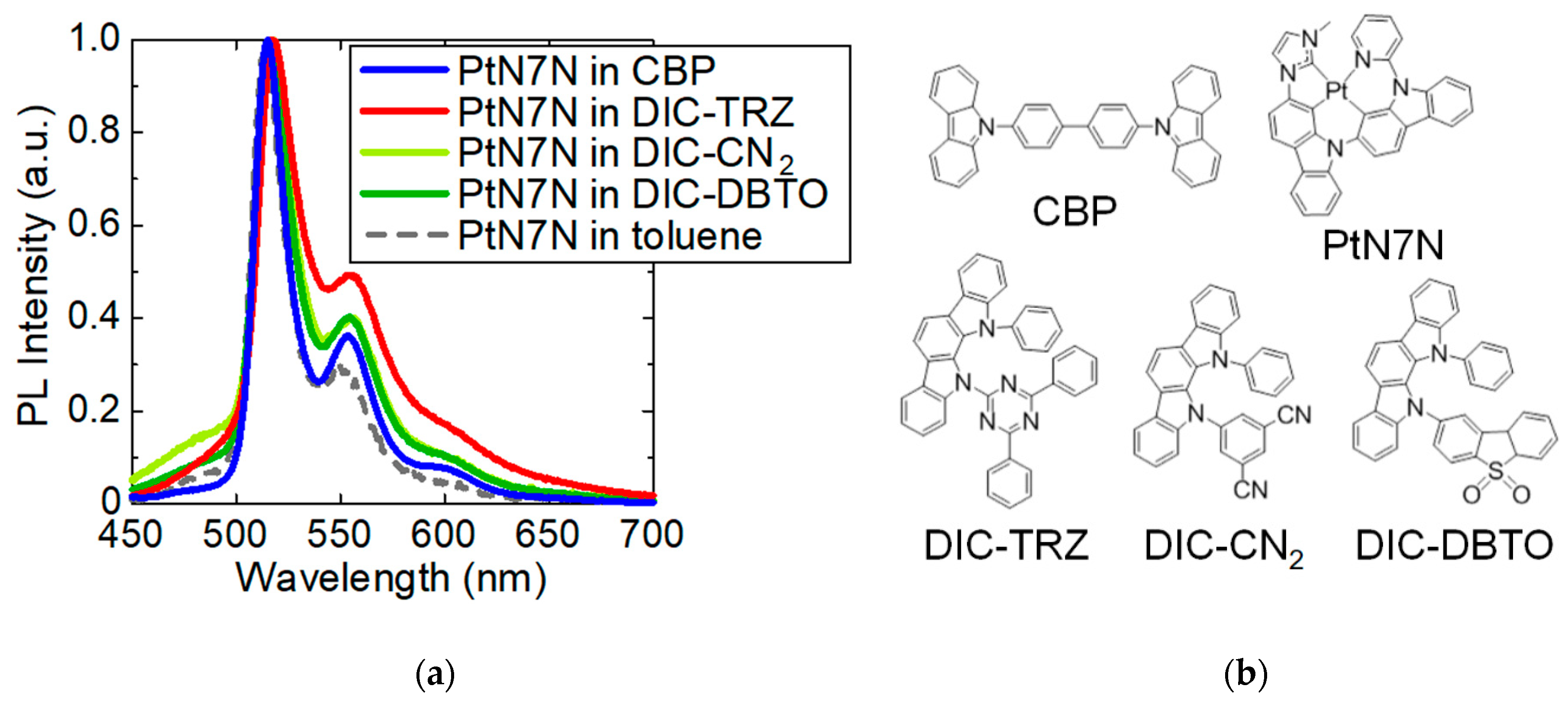
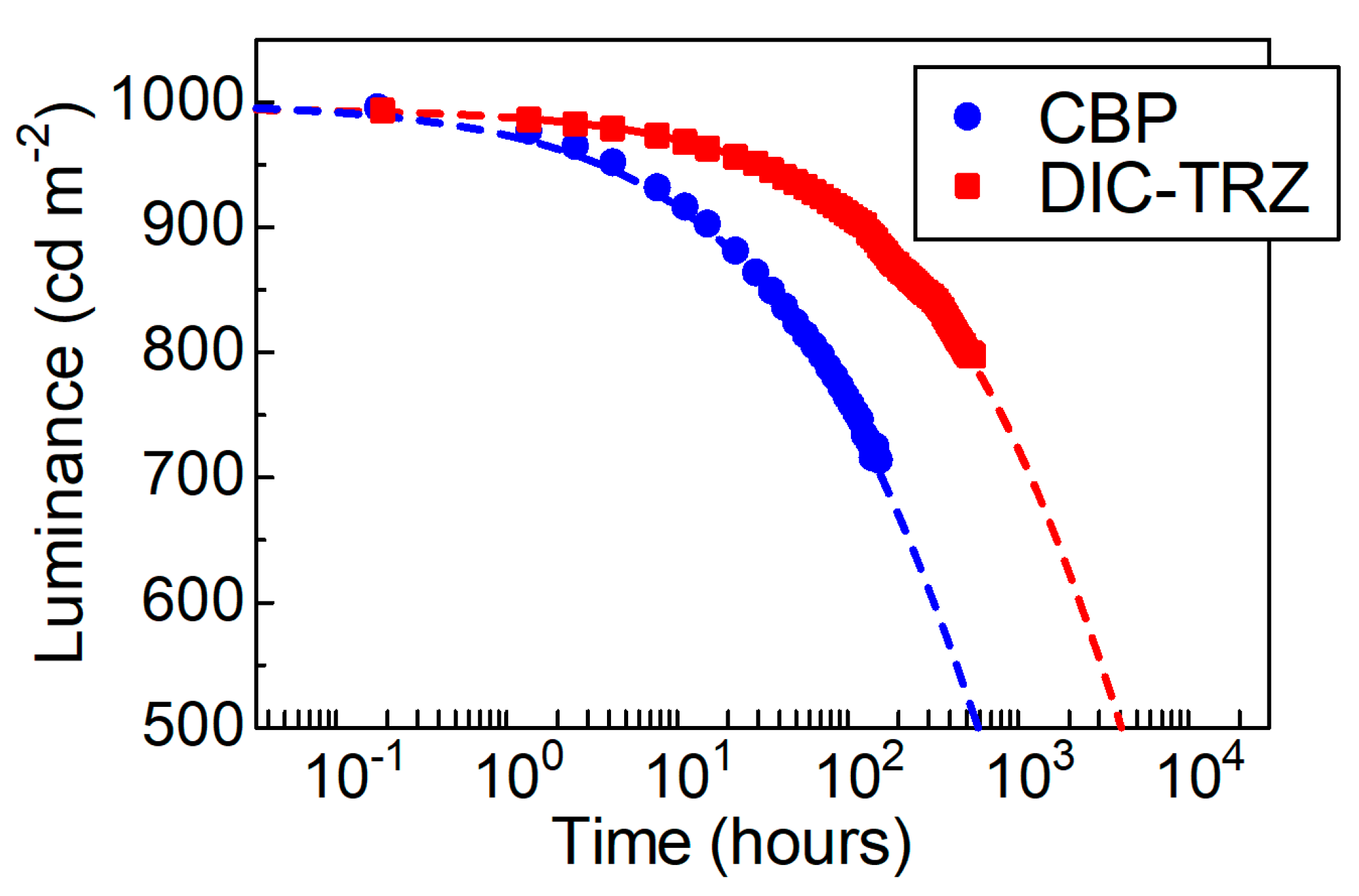
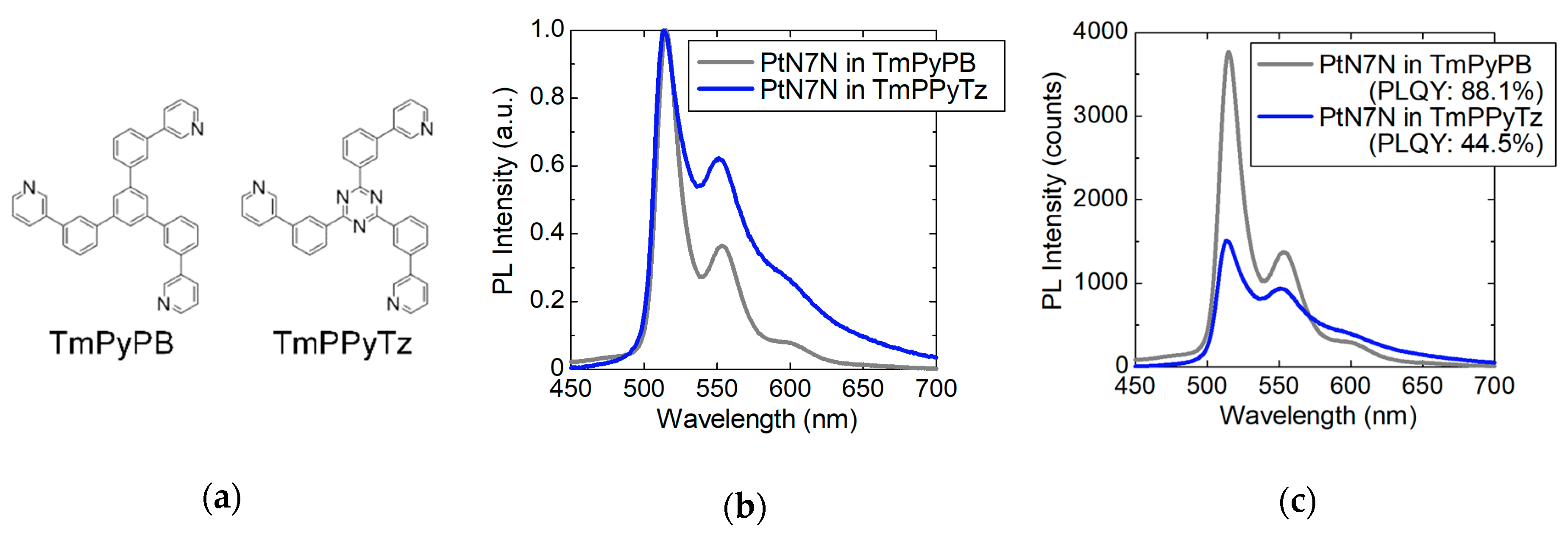

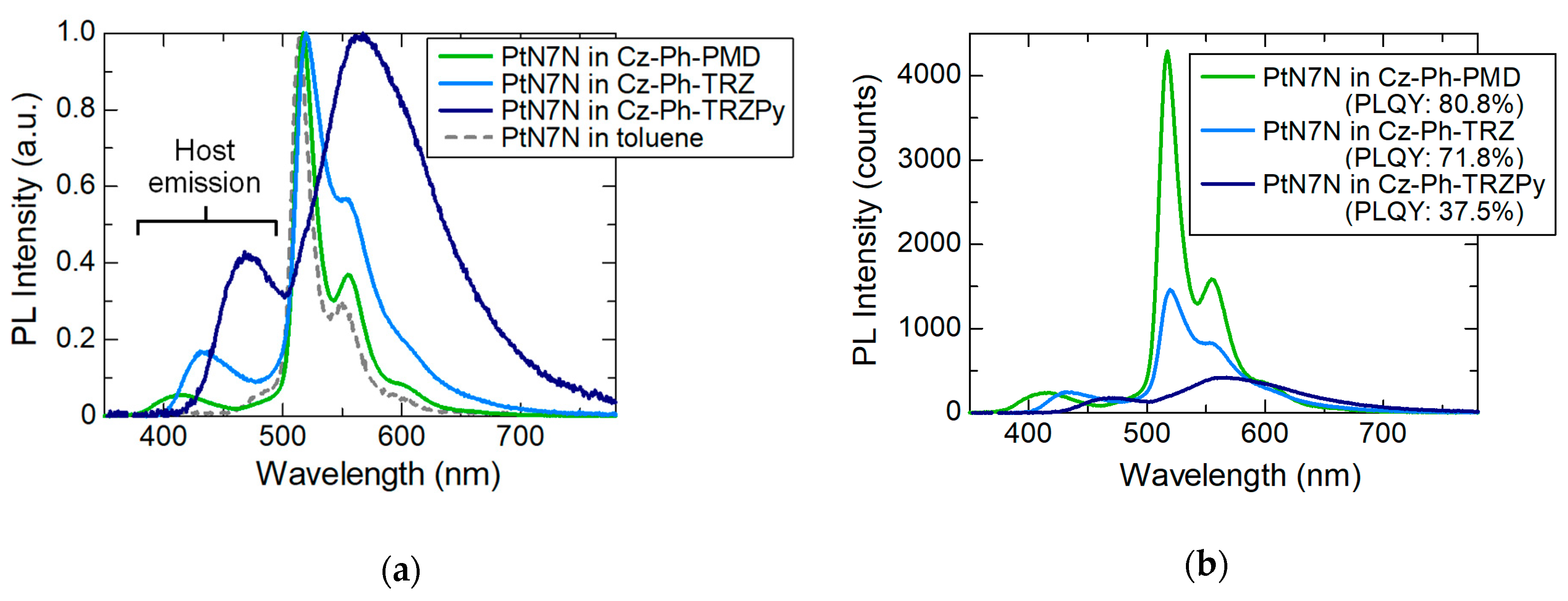
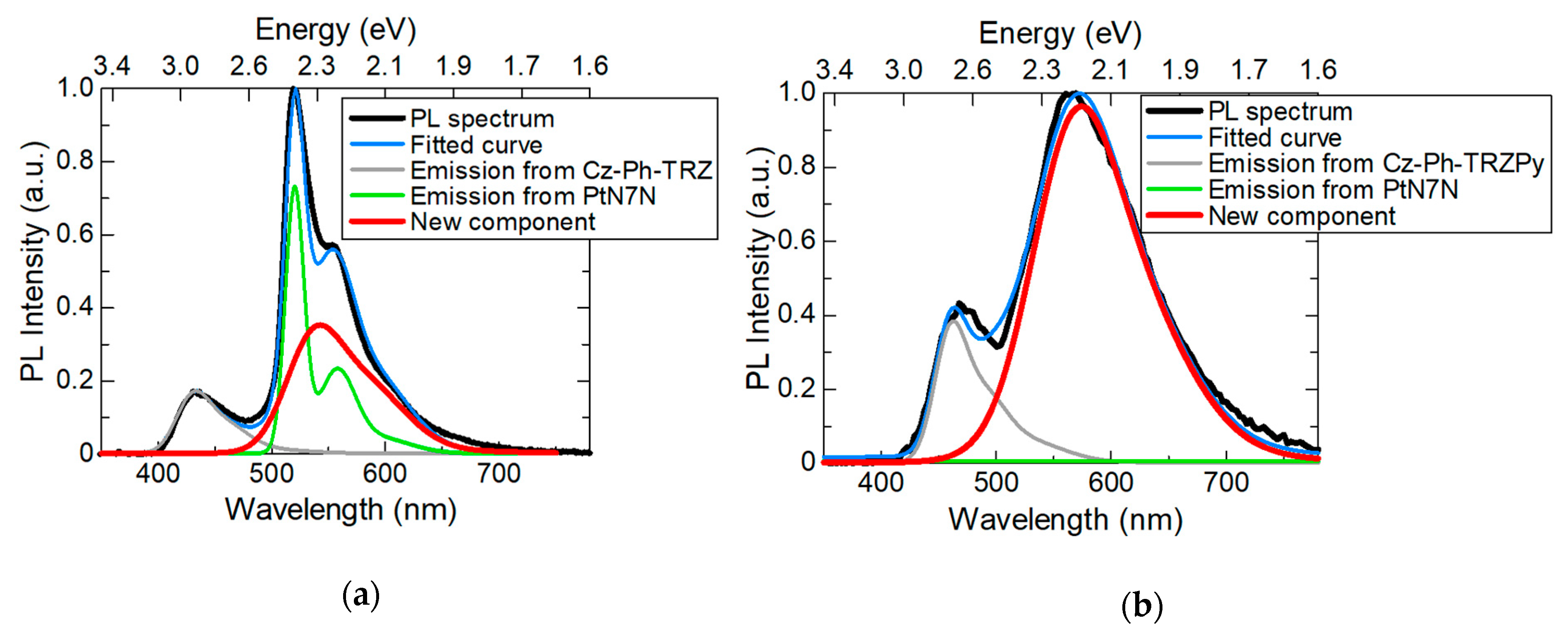

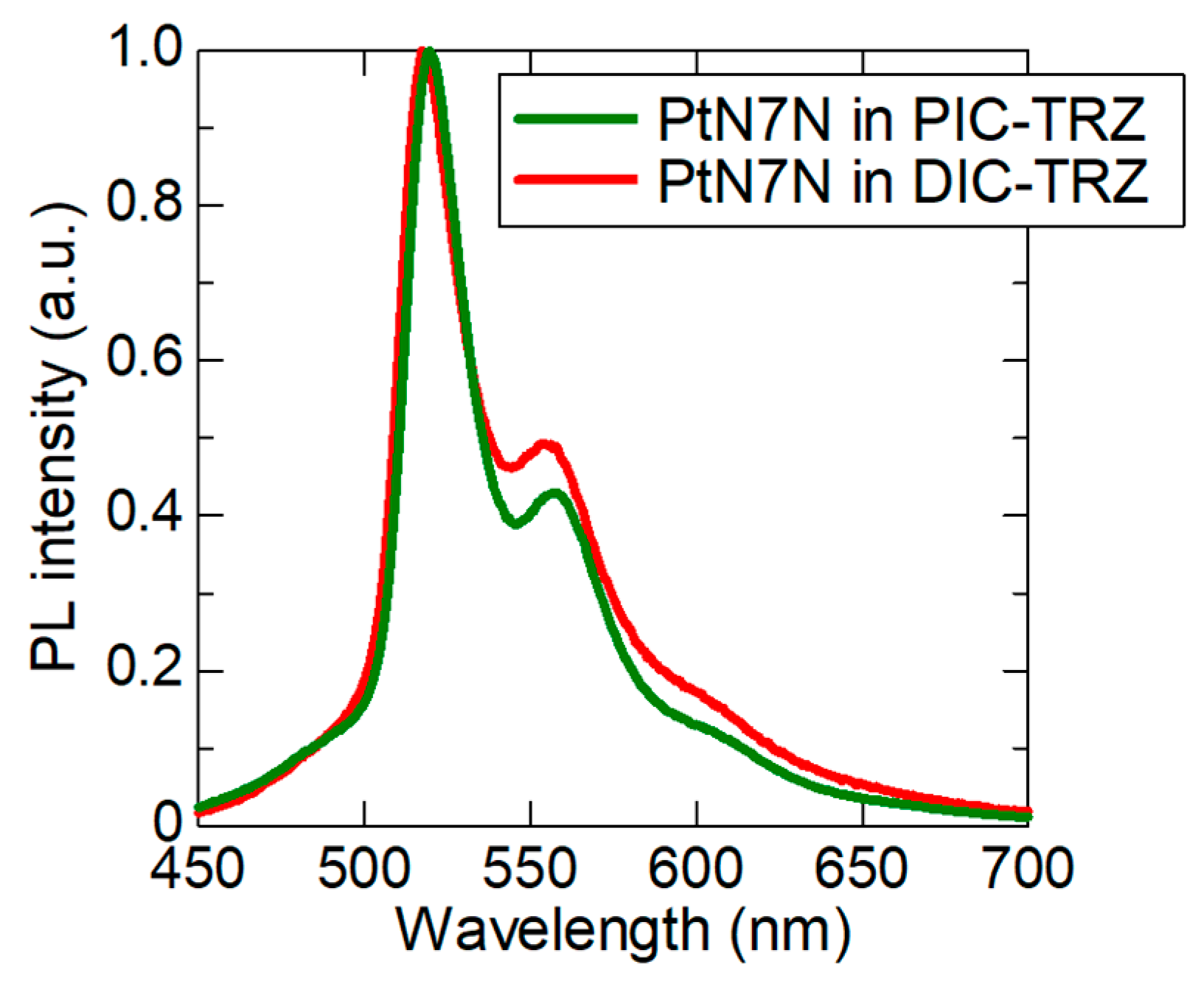
© 2019 by the authors. Licensee MDPI, Basel, Switzerland. This article is an open access article distributed under the terms and conditions of the Creative Commons Attribution (CC BY) license (http://creativecommons.org/licenses/by/4.0/).
Share and Cite
Iwasaki, Y.; Fukagawa, H.; Shimizu, T. Effect of Host Moieties on the Phosphorescent Spectrum of Green Platinum Complex. Molecules 2019, 24, 454. https://doi.org/10.3390/molecules24030454
Iwasaki Y, Fukagawa H, Shimizu T. Effect of Host Moieties on the Phosphorescent Spectrum of Green Platinum Complex. Molecules. 2019; 24(3):454. https://doi.org/10.3390/molecules24030454
Chicago/Turabian StyleIwasaki, Yukiko, Hirohiko Fukagawa, and Takahisa Shimizu. 2019. "Effect of Host Moieties on the Phosphorescent Spectrum of Green Platinum Complex" Molecules 24, no. 3: 454. https://doi.org/10.3390/molecules24030454
APA StyleIwasaki, Y., Fukagawa, H., & Shimizu, T. (2019). Effect of Host Moieties on the Phosphorescent Spectrum of Green Platinum Complex. Molecules, 24(3), 454. https://doi.org/10.3390/molecules24030454





